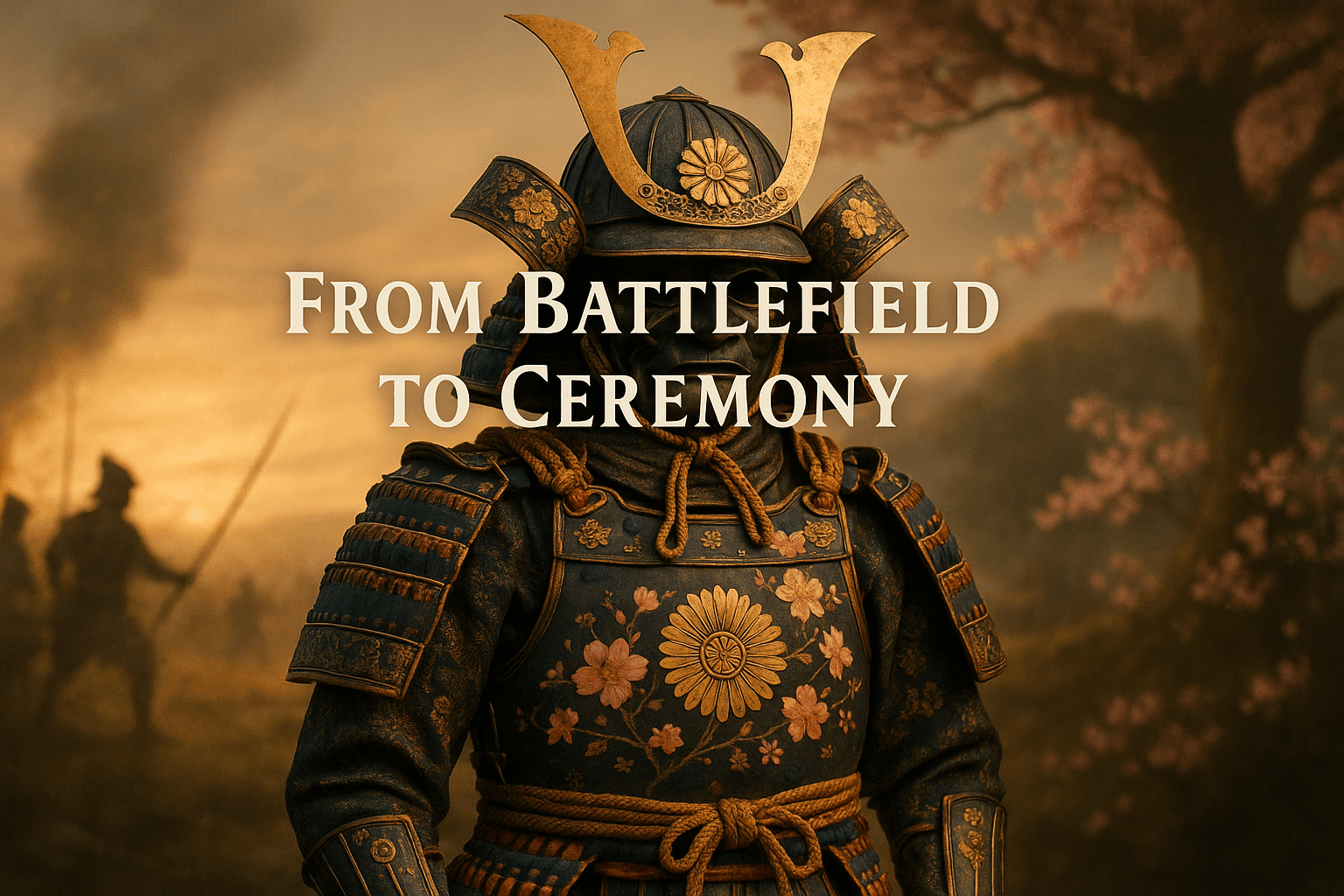Origins of the Armor
The origins of samurai armor trace back to Japan’s early feudal conflicts, when warfare was dynamic, chaotic, and intensely personal. In these formative centuries, protection meant survival, and armor was crafted with stark practicality in mind. The earliest iterations, dating back to the 4th and 5th centuries, were far removed from the ornate suits we associate with samurai today. Known as keiko and, later, ō-yoroi, these early forms of armor were built primarily for mounted archers—constructed from small iron or leather scales called kozane, laced together with silk or leather cords to provide both flexibility and strength.
Designed to shield vital areas without restricting mobility, the armor featured broad shoulder guards (sode), a protecting skirt (kusazuri), and a distinctive boxy silhouette. Every component served a strategic function: deflecting arrows, absorbing sword strikes, and allowing swift movement on horseback. The purity of purpose in this era of samurai armor highlights a time when battlefield necessity forged every curve and crease. As warfare evolved, so too would the armor—but its roots were always grounded in survival and the realities of hand-to-hand warfare.
Form Follows Battle
As warfare evolved across Japan’s tumultuous centuries, so too did the armor of the samurai, shaped as much by shifting tactics as by the forging fires of tradition. Early battles during the Heian period (794–1185) emphasized mounted archery, prompting the development of ō-yoroi, a boxy, lacquered suit designed to protect horseback warriors from arrow volleys. Constructed with heavy lamellar plates and broad shoulder guards, this armor prioritized defense and mobility on horseback but proved less agile for foot combat.
As feudal conflicts intensified during the Kamakura (1185–1333) and Muromachi (1336–1573) periods, the nature of battle changed. Infantry engagements and close-quarters swordplay became more common—calling for armor that allowed faster movement and greater flexibility. The result was the do-maru and haramaki styles, lighter and more form-fitting suits that wrapped around the body, improving maneuverability while maintaining crucial protection.
The introduction of firearms by the mid-16th century brought yet another seismic shift. The bullet-resistant tōsei gusoku, or “modern armor,” emerged in response. Crafted with iron plate components and reinforced cuirasses, this armor sacrificed some elegance for raw defense against musket fire. Face masks became more prominent too—not only for intimidation but for added facial protection.
Form followed function on the battlefield, each iteration a calculated response to how war was fought and won. Samurai armor was not just a static symbol but a resilient, adaptable solution—shaped by strategy and survival.
Materials and Methods
Samurai armor, or yoroi, was a masterpiece of function and form, crafted meticulously by skilled artisans using a diverse palette of materials designed to protect and impress. The foundation of the armor was iron, hammered into plates and scales that formed the resilient core of the cuirass (dō), helmets (kabuto), and other defensive components. These iron pieces were often lacquered, not only to prevent rust but also to add a sleek, polished aesthetic that reflected the warrior’s status.
Silk played an equally vital role, used in the lacing (odoshi) that held the plates together. These colorful cords were more than decorative—their tension and arrangement could affect the flexibility and structure of the armor. The choice of color and style often signaled the wearer’s clan identity or rank, blending utility with symbolism.
Lacquer, made from tree sap, was applied in multiple layers to coat the iron and wood elements. Beyond protection from the elements, lacquer allowed for elaborate decorative motifs, transforming battle gear into an art form. Artisans employed age-old techniques such as embossing, engraving, and makie (gold or silver powder in lacquer) to infuse each piece with personal and cultural significance.
The craftsmanship of samurai armor balanced durability with intricate artistry. Each suit was tailor-made, often taking months to complete, ensuring the armor could withstand combat while simultaneously serving as a visual expression of heritage, honor, and power.
The Warrior and the Way
To the samurai, armor was far more than a means of survival—it was a declaration of identity, values, and allegiance. Every scale and crest reflected bushidō, the code of honor that governed a warrior’s life. Meticulous craftsmanship made each suit a visual testament to courage, discipline, and loyalty. Lacquered surfaces gleamed not just with aesthetic appeal, but with the gravity of a solemn ethical vow.
Clan symbols—mon—stood bold on helmets and breastplates, broadcasting familial ties on the battlefield and in peacetime ceremonies. A samurai’s armor told observers where he came from and what he stood for, functioning like a spiritual banner worn on the body. Color and ornamentation signified rank and social status; crimson cords or intricate etchings marked the elite, while plainer designs distinguished common retainers.
Even as the threats of war diminished, this symbolic language of armor endured. In rituals and processions, samurai retained their ornate gear not out of necessity, but to project the enduring ideals of bushidō. Over time, the practical merged with the philosophical—armor evolved from defense to expression, becoming not merely what the warrior wore, but a reflection of who they were.
A Shift in Purpose
As Japan moved from the chaos of constant warfare into prolonged eras of peace—most notably during the Edo period (1603–1868)—the role of the samurai, and consequently their armor, began to evolve. Once designed purely for protection and mobility on the battlefield, samurai armor transformed into a symbol of status, heritage, and ritual.
In this more stabilized society, where military conflict was rare and the Tokugawa shogunate enforced relative peace, samurai retained their social position but found themselves performing more bureaucratic and ceremonial duties. Armor, no longer a tool of survival, became a canvas to display family crests (kamon), rank, and regional pride. The designs grew increasingly ornate, with elaborate lacquer finishes, gilded embellishments, and dramatic helmets crafted to impress rather than intimidate.
Armor was donned for court processions, religious events, and formal audience with the shogun—settings where tradition and spectacle took precedence over utility. It served as a visual reaffirmation of the samurai’s enduring presence within Japan’s rigid social hierarchy, even as their function shifted from warrior to steward. Ceremony replaced combat, and the armor once tempered by war came to embody the ceremonial soul of the samurai legacy.
Armor as Art
While samurai armor was engineered for survival on the battlefield, it also evolved into a striking form of artistic expression. Beyond its practicality, armor became a canvas for visual storytelling—displaying not only the wearer’s status but also the aesthetic values of the era.
Elaborate color schemes were chosen with care. Deep lacquers of vermilion red or midnight black highlighted different clans or personal preferences, while gold leaf and polished metals added a regal shine. The juxtaposition of textures—lacquered plates, braided silk cords, and ornate leather—offered a dynamic visual contrast, turning functional gear into wearable masterpieces.
Motifs drawn from nature and mythology adorned breastplates and helmets. Dragons symbolized strength and protection, plum blossoms resilience, and waves embodied persistence. Family crests (mon) were prominently positioned, asserting identity and lineage with pride.
Helmets (kabuto) pushed artistic boundaries even further. Elaborate crests shaped like antlers, horns, or celestial symbols turned heads on and off the battlefield, blending intimidation with spiritual resonance. Each embellishment conveyed a silent message to allies and enemies alike—honor, legacy, and a deep-rooted sense of cultural belonging.
Over time, as armor transitioned into ceremonial use, these artistic elements intensified. No longer hindered by the demands of combat, armorers focused on fine craftsmanship, creating pieces that celebrated tradition as much as they once served war. In this way, samurai armor became not only a mark of readiness, but also a revered form of art.
Legacy and Reverence
The legacy of samurai armor transcends its battlefield origins, enduring as a powerful cultural symbol in modern Japan. Far from being relegated to the pages of history books, these meticulously crafted suits remain deeply woven into the fabric of Japanese identity. Museums across the globe—particularly in Japan—carefully preserve and display samurai armor, not merely as historical artifacts but as embodiments of the Bushidō spirit and feudal craftsmanship. Institutions like the Tokyo National Museum and The Samurai Museum in Kyoto offer immersive glimpses into the armor’s artistic and functional evolution, ensuring that the legacy is passed on through the generations.
Contemporary relevance also lives on in traditional festivals, reenactments, and martial arts such as Kendō and Iaidō, where the aesthetic and philosophical echoes of armor continue to inspire respect and discipline. Cultural ceremonies and parades often feature armor replicas worn with dignity, reinforcing the samurai narrative in public consciousness. Even in popular media—film, fashion, anime—the visual language of samurai armor maintains its grip on global imagination.
More than metal and silk, samurai armor has become a vessel for memory and reverence, representing resilience, honor, and an unyielding dedication to one’s code. It no longer simply tells the tale of war—it reflects a centuries-old ethos preserved through both form and spirit.





